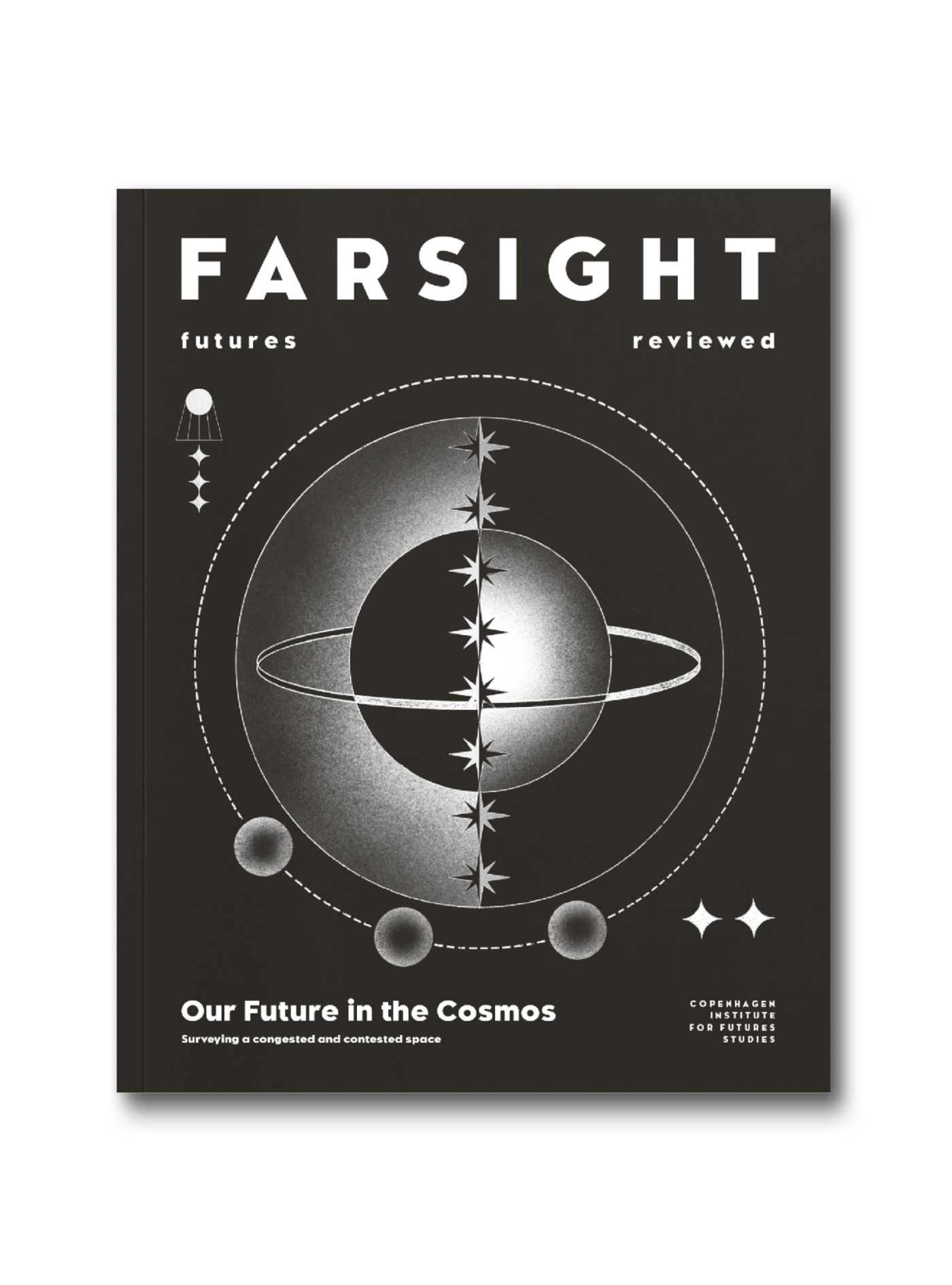
In turn, we use cookies to measure and obtain statistical data about the navigation of the users. You can configure and accept the use of the cookies, and modify your consent options, at any time.

The Danish wunderkind cosmologist, Albert Sneppen, faces some of the most notorious paradoxes within physics.
Illustration: Sophia Prieto
Albert Sneppen has had a short but impressive scientific career. An astrophysics PhD student in his mid-20s, his work has already led to new knowledge in the development of galaxies, supermassive black holes, and what happens when stars collide. Media outlets like the Washington Post and The Guardian have taken note of his contributions to science, which have found their way into some of the world’s most prestigious scientific journals.
In 2021, Sneppen published a mathematical formulation of how light is bent and captured around black holes or other massive objects in space, potentially serving as a reflection of the Universe. His groundbreaking formula garnered immediate international attention for providing new answers to a mystery that had puzzled physicists for decades. Then, in 2022, he and a team of colleagues made headlines again after discovering that kilonovae – giant explosions that result from the collision of two neutron stars – exhibit characteristics that hadn’t previously been noticed, including that they are almost perfectly spherical in shape.
Physics is filled with strange paradoxes and unsolved mysteries. Creativity, Sneppen believes, is a key ingredient in solving them. So, when I visited him at his office at the Niels Bohr Institute in Copenhagen, I decided to ask his opinion on some of the weirder physics problems and hypotheses that stretch the limits of creative thinking.
The first hypothesis, arguable the strangest of the bunch, was formulated by Ludwig Boltzmann. The Austrian physicist asked us to imagine the possibility that everything we see around us, including all our memories and experiences, are figments of a free-floating consciousness – a statistical fluctuation in an infinitely large, old, and chaotic universe…

Broaden your horizons with a Futures Membership. Stay updated on key trends and developments through receiving quarterly issues of FARSIGHT, live Futures Seminars with futurists, training, and discounts on our courses.
become a futures memberAlbert, I’m sure you are familiar with Ludwig Boltzmann’s thought experiment, which says that it might be more likely for a brain to form spontaneously in a void – for a split-second before collapsing – complete with a memory of having existed in our universe, than it is for a brain to emerge via evolution. It’s comparable to the notion of a room filled with chimpanzees hammering out Shakespeare on their typewriters if left alone long enough.
It seems ridiculous to me, and like the kind of thing that will drive you insane if you think about it long enough, but I’m not a physicist. What do you think?
This one is a mouthful. The paradox at the root of this idea is incredibly hard to deal with because it’s based on some unanswered questions. One is whether the universe is infinitely big. Another is whether it will be infinitely old.
The likelihood of a bunch of particles clustering together somewhere in space to produce a brain is of course very, very small. It would require all the right atoms to spontaneously combine in a certain way. It’s almost impossible. But if the universe is infinitely old, then very small numbers multiplied by infinity means that something as outlandish as this would eventually happen.
As a physicist, it’s not very useful to me, as I can’t prove nor disprove it. But it does confront us with how absurd the idea of an infinite, or an infinitely old, universe is.
This next one seems more likely to me, considering all the recent UFO chatter. I’d like to hear what you think of the ‘zoo hypothesis’. It posits that aliens do exist, but that they maintain a strict ‘hands-off’ policy concerning Earth.
We, who view ourselves as an advanced species, are, in reality, very primitive — comparable in primitiveness to the other inhabitants of the universe as ants are in relation to us. We are meant to be isolated and studied until we attain a certain level of ethical and technological maturity. Earth is a wild park. Or, in a more extreme interpretation, a large biological laboratory where humans are the experimental subjects.
I don’t think this one is very likely, but the idea points to a fundamental paradox. We know that the universe is very big. The Milky Way alone is home to 100 million stars, and there are billions and billions of galaxies in the observable universe alone. Multiply those numbers and you quickly realise that there’s a potential for life existing in many different places. It’s obviously not impossible for the universe to create life, because it did so here on Earth. So, the question is why we haven’t detected any other lifeforms outside of Earth – where is everyone else?
There are many solutions to that paradox that don’t involve us being in a cosmic zoo. One solution is that life is unstable; when life becomes sufficiently intelligent, it destroys itself – perhaps via a nuclear technology that sets fire to the atmosphere. Or perhaps the universe is simply a very inhospitable place that eventually kills off life.
It’s a puzzling question because the universe is 13 billion years old. Earth has been around for 4.5 billion years. So why are we the first intelligent beings to inhabit it? That’s not an easy question to answer.
The question also presupposes that if there’s life out there, it must be close enough for us to observe. But perhaps that isn’t the case. It could be that there’s plenty of life in the universe but nothing close to our corner of the galaxy. We’ve only recently (in a cosmic timeframe) started to communicate via radio waves, so perhaps no one has received them yet or has been able to respond.
Ultimately, I don’t buy it. I think the alternative explanations are much better.
This next hypothesis was formulated in 1982, when a team of researchers in Paris discovered that subatomic particles like electrons, under certain circumstances, are capable of instantaneously communicating with each other. Somehow, each particle knows what the other is doing, regardless of how far apart they are, challenging Einstein’s assertion that no communication can travel faster than the speed of light.
One of the most radical attempts to patch the gap came from physicist David Bohm, who suggested that the findings implied the nonexistence of objective reality. According to Bohm, the universe, despite its apparent solidity, could be a colossal and intricately detailed hologram. This, he believed, would explain why subatomic particles can seemingly break the laws of physics. So, our beautiful 3D playground is essentially just a projection from a mundane flat 2D boundary, and we live in a kind of cosmic simulation, making us all holographic beings. What do you make of this one?
There are several parts to this one that are intriguing. Fundamentally, there’s a connection between information about us as three-dimensional beings and information that can be stored on a two-dimensional plane.

Explore the world of tomorrow with handpicked articles by signing up to our monthly newsletter.
sign up hereThere’s a similar idea to this which suggests that the entire universe could be mirrored in a black hole – that everything that exists could be written along its edge due to how black holes are able to ‘trap’ light in their orbits. The idea is based on a deep mathematical correspondence that we don’t yet know what means. This mathematical correspondence is not necessarily something that changes the laws of physics. But for now, it’s not something we can rule out. All we know is that there is something deep at play in the connection between the surfaces of black holes and us as three-dimensional beings.
So, this one’s a maybe.
One last hypothesis. This began as a thought experiment in the late 1980s and was later more fully formulated by physicist Max Tegmark. He suggests that we may die many times in our lives, but each time it happens, our consciousness shifts to a different timeline where we are still alive. This means that we can experience death and remain alive in another dimension.
Quantum immortality has its roots in the so-called Many-Worlds interpretation of quantum mechanics, which suggests that every possible outcome of a quantum measurement occurs in a separate parallel universe, and that an infinite number of parallel universes exist in different timelines.
Albert, quantum immortality – yes or no?
The Many-Worlds theory is something that I have a troubled relationship with. When we say that anything could happen because we could never know if these other realities exist or not, that to me is no longer physics. If we can’t do experiments or test the validity of the math, then we are closer to religious belief. We can’t say if something is right or wrong because we won’t be able to ever prove or disprove it.
Many of the great scientists of the past were religious believers – and we physicists are not immune to letting our beliefs influence our thinking. Einstein didn’t like the idea that the universe had a beginning. He’d rather have a static universe. But that idea wasn’t necessarily grounded in physics.
What’s beautiful about the scientific method is that assumptions can be disproven, just as Einstein’s assumption eventually was when it was discovered that the Big Bang was the beginning of the Universe. He had to let go of his belief of a static universe, and he considered that belief to be his biggest mistake even though the equations he himself formulated were used to disprove it.
Let’s end in the furthest future imaginable. This is a question, not a hypothesis: The most widely accepted explanation for how the universe will end is the ‘heat death’ — a state where all energy is dispersed, stars have burned out, and the universe becomes a dark, cold, and inactive place. This is the prevailing theory, but are there any conceivable alternatives?
What we do when we talk about the heat death is that we extrapolate. We know that the universe is 13 billion years old. That’s 13 followed by nine zeros. It might be a big number, but it’s not very big when compared to the number of years it will take to reach the end of the Universe – a one followed by 100 zeros. So, the heat death is at the end of a time scale that is absolutely massive when compared to the relatively young life of our current universe.
That, added to the fact that our current model of the universe is very incomplete and requires things like dark energy and dark matter which we don’t understand, means that we are speculating about a future we don’t know. There are other versions of the end of the universe. It could be that the universe moves in cycles – that it bounces into itself and gives birth to itself once more. But our current best theory is this idea that dark energy will slowly stretch the universe, so everything becomes equally distributed. This means that time will no longer exist – there will be no difference between tomorrow and today – and everything is boring and bleak. Ultimately, we don’t know. But one day, hopefully, we will.

This is an article from FARSIGHT:
Our Future in the Cosmos
Grab a copy here